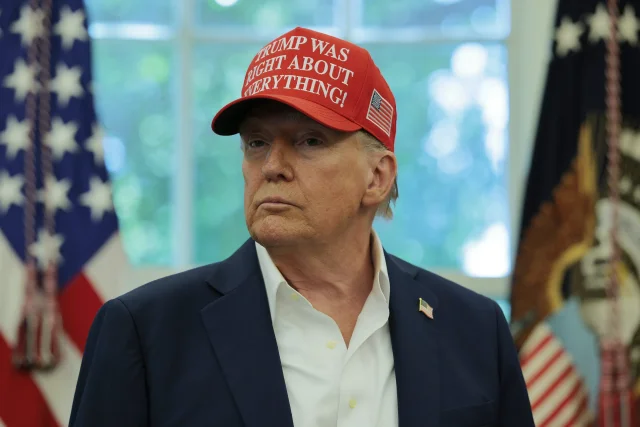
President Donald Trump’s hike in tariffs is projected to generate enough revenue to cut federal deficits by $4 trillion over the next decade, according to the latest analysis by the Congressional Budget Office (CBO). The nonpartisan agency said it had updated its estimates of tariff revenues as part of the development of the short-term economic forecast covering 2025 to 2028, to be published on Sept. 12.
The CBO report found that increased tariffs—many targeting imports from China, Mexico, Canada, and the European Union as well as automobiles, steel, and other goods—have raised effective tariff rates by about 18 percentage points compared to last year. If these rates remain, primary deficits would shrink by $3.3 trillion and interest payments would fall by another $700 billion, bringing the total deficit reduction to $4 trillion over 10 years.
Impact of tariffs on deficit
Higher tariff revenues mean less need for federal borrowing, resulting in significant savings on national debt interest payments. This marks a substantial revision from the CBO’s June estimates following recent hikes in tariff rates and broader coverage across key imports, when the agency projected a $2.5 trillion decrease in primary deficits and $500 billion reduction in interest outlays in a report that examined the effects of the tariffs implemented between Jan. 6 and May 13, 2025. The CBO said it used the same methods to generate the projections, mainly based on data from the Census Bureau, Customs and Border Protection, and the Treasury.
The study notes that tariff revenue could partially offset deficits caused by new tax cuts and spending bills, such as the One Big Beautiful Bill Act, which is expected to raise deficits by $3.4 trillion, also according to the CBO. However, legal challenges and evolving trade negotiations may impact future tariff-related revenues, the CBO cautioned.
Wider economic context
The federal debt currently stands at about $37 trillion, and analysts remain concerned about upward pressures on interest rates and borrowing costs due to rising debt levels. Lawmakers are also facing a government funding deadline at the end of September, which places added scrutiny on deficit management in upcoming fiscal debates.
Separately, the Committee for a Responsible Federal Budget (CRFB), a nonpartisan budget watchdog that sits outside the government, has calculated that Trump’s tariff regime, if kept permanent, could reduce the deficit by up to $2.8 trillion in the next decade. The CRFB called the revenue being generated by the tariffs both “meaningful” and “significant.”
It’s an open question whether the tariffs will offset the impact of OBBBA, from a deficit standpoint. The CRFB has gamed out several scenarios—including the bulk of the tariffs being ruled illegal and thrown out by an appeals court—and warned that the nation’s finances have “deteriorated” since January. In June, the CRFB also warned that the tariffs wouldn’t cover the costs of OBBBA. However, the CBO’s significant upgrade of deficit reduction calls that calculation into question. Still, there is the question of who “eats” the tariffs, to paraphrase Trump’s famous instructions to Walmart about its margins. As many economists have noted, the tariffs essentially function as a sales tax on American consumers, so the deficit reduction is coming from, more or less, you and me.
While Trump and supporters frame tariffs as a key tool for deficit reduction without raising taxes on U.S. households, critics caution about broader economic impacts, including higher consumer prices and trade tensions. The CBO indicates its projections assume ongoing tariff regimes, noting that changes in trade policy or international negotiations could alter the fiscal outlook.
Link to original article;
https://fortune.com/2025/08/25/how-much-revenue-deficit-reduction-trump-tariffs-cbo-4-trillion/

Are you still accumulating any physical Gold at these prices or do you think it will come down?
I am currently not accumulating any gold nor silver. I’m not accumulating any cryptos, either. Of course, circumstances may change and I may find an opportunity in the future.
I made this choice, not because I think the prices are coming down, but rather, I have been spending a lot of money on my rental properties over the past couple years as I reconfigure the portfolio.
My overriding concern is that asset values of all sorts are stretched historically speaking. There is some fundamental basis for the price of housing, but stocks are somewhat overvalued when compared to earnings and everything else seems very rich in value.
For me, I would like to keep a little cash sitting around in case we see something like early 2020 again. I wouldn’t be as aggressive as Buffett in raising cash, but I do understand his mindset.
I do want to add here. Of all the assets out there, gold offers its holders the best downside price risk protection. I feel that my gold holdings are safe against downside price shocks. I do not get that with silver.
Headline number looks weak, but a deeper revealing indicates stronger than expected data. Overall, not bad.
Core Durable Goods Orders (MoM) (Jul)
Act: 1.1% Cons: 0.2% Prev: 0.3%
Durable Goods Orders (MoM) (Jul)
Act: -2.8% Cons: -3.8% Prev: -9.3%
Durables Excluding Defense (MoM) (Jul)
Act: -2.5% Cons: -3.6% Prev: -9.5%
Goods Orders Non Defense Ex Air (MoM) (Jul)
Act: 1.1% Cons: 0.3% Prev: -0.6%
Weaker than expected house price data from both FHFA and the Case Shiller….
FHFA House Price Index (MoM) (Jun)
Act: -0.2% Cons: -0.1% Prev: -0.1%
FHFA House Price Index (YoY) (Jun)
Act: 2.6% Cons: Prev: 2.9%
FHFA House Price Index (Jun)
Act: 433.8 Cons: Prev: 434.6
S&P/CS HPI Composite – 20 s.a. (MoM) (Jun)
Act: -0.3% Cons: Prev: -0.3%
S&P/CS HPI Composite – 20 n.s.a. (MoM) (Jun)
Act: 0.0% Cons: Prev: 0.4%
S&P/CS HPI Composite – 20 n.s.a. (YoY) (Jun)
Act: 2.1% Cons: 2.1% Prev: 2.8%
Slowly creeping upward over the past 6 months or so.
CB Consumer Confidence (Aug)
Act: 97.4 Cons: 96.4 Prev: 98.7
Recall the hullabaloo about the NAU? Trump played the Canadian and Mexican voters like two well-oiled Stradivarius violins.
MAGA!🤣🤣🤣🤠🤠🤠